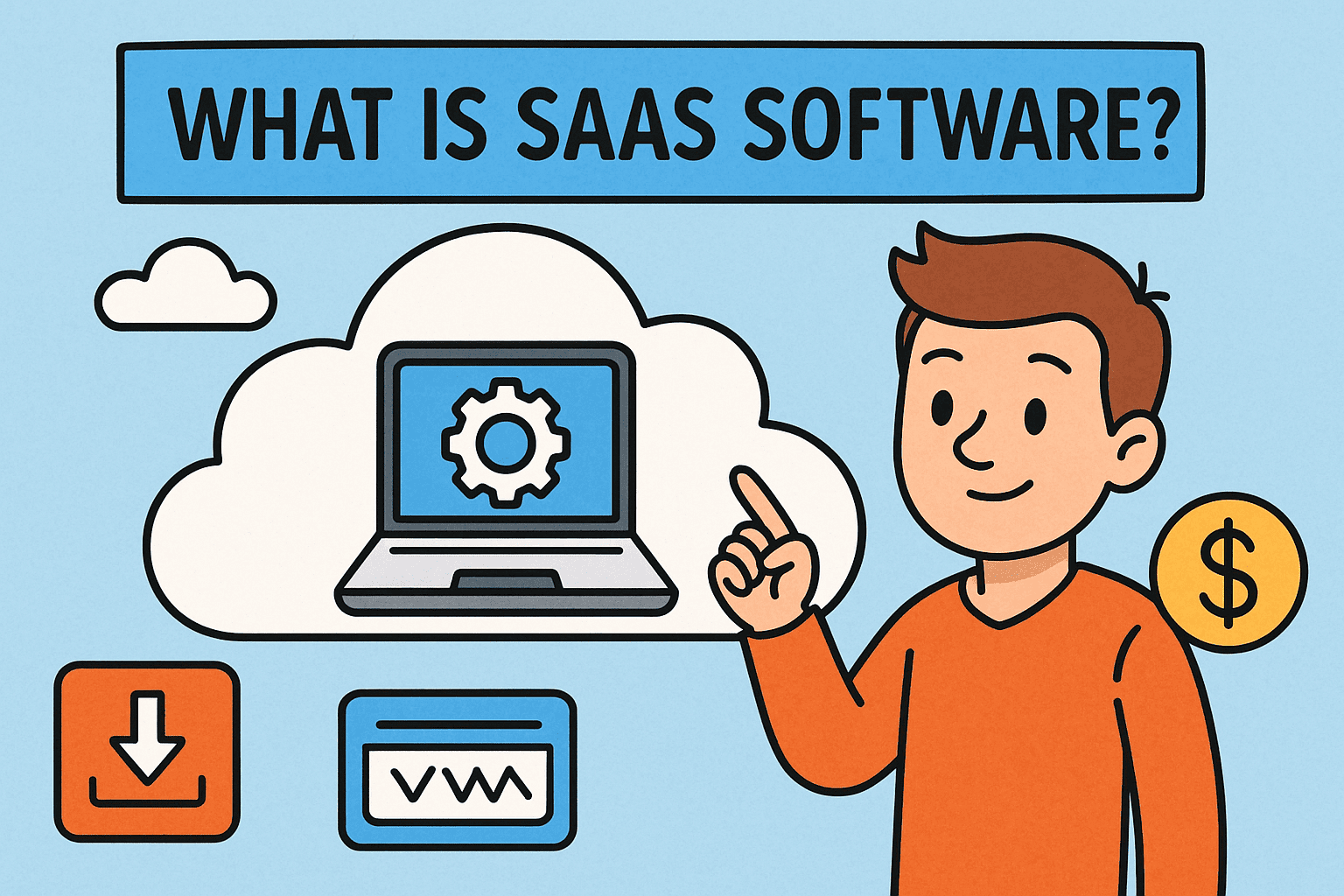Updated on September 24, 2025, by OpenEDR
Have you ever wondered what is SaaS software and why nearly every modern business is adopting it? From Gmail to Salesforce, Software-as-a-Service (SaaS) has become the dominant model for delivering applications in the digital era.
SaaS eliminates the need for businesses to install and maintain complex software locally. Instead, applications are hosted in the cloud and accessed through a browser. This approach saves money, improves flexibility, and strengthens security—making SaaS a game-changer for IT managers, CEOs, and cybersecurity leaders.
In fact, Gartner predicts that SaaS revenue will exceed $232 billion in 2025, proving just how integral it is to modern business strategy.
What Is SaaS Software?
SaaS (Software as a Service) is a cloud-based software delivery model where applications are hosted by a provider and made available to users over the internet. Instead of buying and installing software, companies subscribe to SaaS applications on a pay-as-you-go basis.
Key features of SaaS software:
Hosted in the cloud
Accessed via browser or app
Subscription-based pricing
Automatically updated by providers
👉 In simple terms: SaaS allows businesses to use powerful software without the burden of maintenance, infrastructure, or high upfront costs.
How SaaS Software Works
To understand what is SaaS software, let’s break it down:
Hosting – SaaS providers host applications on their servers in secure data centers.
Access – Users connect through a web browser or mobile app.
Authentication – Secure login ensures authorized access.
Subscription Model – Companies pay monthly or yearly fees.
Maintenance – Providers handle updates, patches, and security.
Example: Microsoft 365 is a SaaS solution. Instead of installing Office software, users log in online to access Word, Excel, and Outlook seamlessly.
SaaS vs Traditional Software
| Feature | SaaS Software | Traditional Software |
|---|---|---|
| Deployment | Cloud-hosted | Installed locally |
| Cost | Subscription-based | Large upfront licensing |
| Maintenance | Provider-managed | Customer responsibility |
| Updates | Automatic | Manual installation |
| Scalability | Easy to scale | Limited, requires hardware |
👉 Verdict: SaaS offers flexibility and lower costs, while traditional software often requires heavy IT resources.
Benefits of SaaS Software
For IT managers and executives, the advantages of SaaS are clear:
Cost Savings – No expensive hardware or upfront licenses.
Scalability – Add or remove users as needed.
Accessibility – Access from anywhere with an internet connection.
Automatic Updates – Stay secure without manual patching.
Collaboration – Enables remote and hybrid teams to work seamlessly.
Security – Centralized management with built-in encryption and compliance support.
Challenges of SaaS Software
Like any technology, SaaS comes with challenges:
Data Security Risks – Sensitive data stored off-site raises compliance concerns.
Vendor Lock-In – Businesses may depend heavily on a single provider.
Downtime – Internet outages can disrupt access.
Limited Customization – SaaS tools may lack deep configurability compared to on-premise software.
👉 Solution: Pair SaaS with EDR (Endpoint Detection & Response) and Zero Trust security to mitigate risks.
Popular Examples of SaaS Software
When exploring what is SaaS software, real-world examples bring clarity:
Google Workspace – Productivity apps like Gmail, Docs, and Drive.
Salesforce – Customer relationship management (CRM).
Slack – Business communication and collaboration.
Zoom – Video conferencing and remote meetings.
Dropbox – Cloud-based storage and file sharing.
SaaS in Cybersecurity
SaaS plays a vital role in modern cybersecurity strategies:
Secure Collaboration – SaaS enables remote teams to share data safely.
Compliance Support – Providers often meet standards like GDPR, HIPAA, and ISO.
Threat Detection – Many SaaS platforms integrate AI-driven security.
Endpoint Security – SaaS complements EDR to safeguard business devices.
👉 Example: A financial firm may use SaaS-based email with built-in spam filters while deploying OpenEDR to secure endpoints.
SaaS vs PaaS vs IaaS
| Category | SaaS (Software) | PaaS (Platform) | IaaS (Infrastructure) |
|---|---|---|---|
| Purpose | End-user applications | Developer tools | Servers, storage, VMs |
| Example | Microsoft 365, Slack | Google App Engine | Amazon AWS EC2 |
| Target | Business users | Developers | IT departments |
Best Practices for SaaS Adoption
To maximize SaaS benefits, businesses should:
✅ Conduct security assessments of SaaS providers.
✅ Integrate SaaS with EDR and Zero Trust policies.
✅ Monitor usage to avoid shadow IT.
✅ Encrypt sensitive data before uploading.
✅ Train employees on SaaS security best practices.
Why SaaS Alone Isn’t Enough
While SaaS improves efficiency, it doesn’t replace full security. Attackers may still target endpoints, employee credentials, or insider threats.
That’s why organizations should combine SaaS with:
Endpoint Detection & Response (EDR)
Firewalls & Intrusion Detection
Multi-Factor Authentication (MFA)
Employee Awareness Training
👉 SaaS boosts productivity, but EDR ensures threats are detected and stopped in real time.
FAQs: What Is SaaS Software?
1. Is SaaS the same as cloud computing?
Not exactly. SaaS is a type of cloud computing focused on delivering applications.
2. Do small businesses benefit from SaaS?
Yes. SaaS reduces upfront costs and makes enterprise-level tools accessible.
3. Is SaaS secure?
Yes, but businesses should review providers’ security measures and add extra protection like EDR.
4. Can SaaS work offline?
Most SaaS requires internet access, but some apps allow limited offline functionality.
5. What industries use SaaS the most?
Finance, healthcare, education, and e-commerce rely heavily on SaaS.
Conclusion: SaaS as the Future of Business Software
So, what is SaaS software? It’s a cloud-based delivery model that enables businesses to use applications without managing infrastructure. With benefits like cost savings, scalability, and automatic updates, SaaS is now the standard for modern enterprises.
However, SaaS should be part of a layered security strategy. To fully protect your business, combine SaaS with endpoint security, Zero Trust, and advanced solutions like OpenEDR.
👉 Secure your SaaS-powered business today: Register for OpenEDR Free
